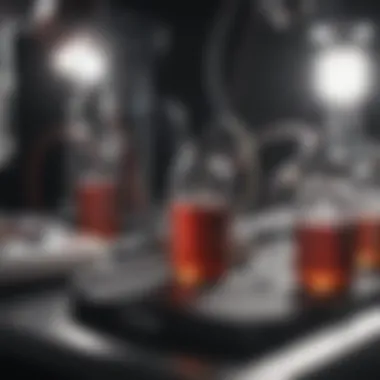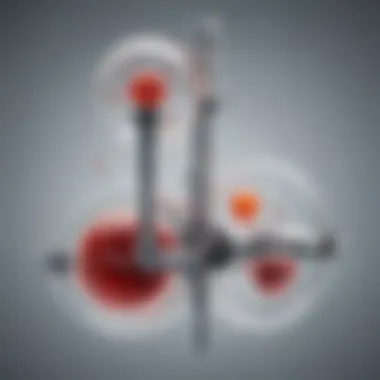Measuring Blood Oxygen Levels: Techniques and Insights


Intro
Key Concepts
Definition of Primary Terms
Before diving into the measurement techniques, it is essential to clarify some key terms:
- Oxygen Saturation: This term refers to the percentage of hemoglobin molecules in the blood that are saturated with oxygen. Normal oxygen saturation levels range from 95% to 100% in healthy individuals.
- Arterial Blood Gas Analysis (ABG): A diagnostic test that measures the levels of oxygen and carbon dioxide in the blood. It also evaluates blood pH, providing insights into a patient’s respiratory and metabolic status.
- Pulse Oximetry: A non-invasive method that estimates oxygen saturation by measuring the light absorption of oxygenated and deoxygenated hemoglobin in the blood.
Related Concepts and Theories
The measurement of blood oxygen levels ties into larger physiological concepts, such as:
- Respiratory Physiology: Understanding how oxygen is transported from the air to the bloodstream is fundamental. The exchange takes place in the alveoli of the lungs.
- Cardiac Output: The volume of blood the heart pumps per minute is directly related to the efficacy with which oxygen is delivered to tissues.
- Hypoxemia: This clinical condition occurs when there is inadequate oxygen in the blood, necessitating measurement and potential intervention.
Methods of Measurement
Arterial Blood Gas Analysis
This method is considered the gold standard for measuring various blood gases, including oxygen levels. Generally, blood is drawn from an artery, often the radial artery in the wrist.
"ABG analysis provides critical insights into a patient’s oxygenation status and acid-base balance, crucial for effective treatment planning."
Pulse Oximetry
Pulse oximeters are widely used due to their non-invasive nature and ease of use. A small device clips onto a fingertip or earlobe and emits light wavelengths to determine oxygen levels based on the color of the blood.
- Advantages include rapid results and comfort.
- Limitations may arise in cases of poor circulation or skin pigmentation, which can affect accuracy.
Future Directions
Gaps Identified in Current Research
Recent studies have revealed inconsistencies in the accuracy of pulse oximetry readings, particularly in specific populations. These areas require further investigation to enhance measurement reliability.
Suggestions for Further Studies
- Developing advanced algorithms for pulse oximetry to improve accuracy under diverse conditions
- Exploring the long-term implications of chronic hypoxemia on health
Prelims to Blood Oxygen Levels
Understanding blood oxygen levels is essential in both clinical and non-clinical settings. Oxygen saturation in the blood plays a pivotal role in determining an individual's overall health. When blood carries enough oxygen, it ensures vital organs and tissues function optimally. Conversely, inadequate oxygen levels can lead to serious health complications, making it crucial to measure and monitor this parameter effectively.
Healthcare professionals rely on precise oxygen level measurements to diagnose various conditions, manage treatment plans, and assess a patient’s response to therapy. Furthermore, understanding the nuances of oxygen levels can aid in better decision-making in emergencies as well as in routine health evaluations.
In the subsequent sections, we will delve into the significance of oxygen levels and explore the physiological role of oxygen in the human body. These discussions will provide a foundation for comprehending the methodologies used to measure blood oxygen levels and why they matter in clinical practice.
Significance of Oxygen Levels
Maintaining appropriate oxygen saturation is vital for sustaining life. Oxygen is the lifeblood of energy production within cells; it acts as a catalyst for cellular respiration. In essence, oxygen levels significantly influence metabolic processes, which are crucial for health. When patients present with symptoms like shortness of breath, fatigue, or confusion, assessing oxygen levels becomes a part of the diagnostic process.
By identifying low oxygen saturation, healthcare providers can intervene promptly. Interventions may include supplemental oxygen administration or more advanced treatments for pulmonary or cardiac conditions. Thus, understanding the significance of oxygen levels illuminates its central role in patient health.
Physiological Role of Oxygen
Oxygen serves multiple physiological roles in the body. It is primarily involved in mitochondrial respiration, which is necessary for converting nutrients into energy. This process occurs in almost every cell type, underscoring the omnipresence of oxygen's influence on bodily functions.
Oxygen also helps in the synthesis of ATP (adenosine triphosphate), which is an energy currency cell need. Furthermore, oxygen enables the removal of carbon dioxide, a waste product of metabolism, from the bloodstream. Without adequate oxygen supply, cells become dysfunctional, leading to impaired organ function.


In this manner, monitoring blood oxygen levels can serve as a critical indicator of physiological stability and is foundational for timely medical interventions.
"Monitoring blood oxygen levels is crucial in identifying and treating hypoxia, a condition that can result in severe organ damage if not addressed promptly."
Thus, the examination of blood oxygen levels provides insights into a patient's metabolic state, aiding healthcare professionals in delivering effective care.
Understanding Hemoglobin and Oxygen Transport
The significance of understanding hemoglobin and its role in oxygen transport cannot be overstated in the context of measuring oxygen levels in blood. Hemoglobin is a vital protein contained in red blood cells, responsible for carrying oxygen from the lungs to tissues throughout the body. This transport mechanism is crucial for maintaining cellular metabolism and overall health. Knowing how hemoglobin functions provides insights into how oxygen levels are measured and interpreted in medical settings.
Hemoglobin Structure
Hemoglobin is a complex protein made up of four polypeptide chains, each consisting of an alpha and a beta chain. This quaternary structure allows hemoglobin to bind oxygen molecules effectively. Within each chain is a heme group, which contains iron at its center. The iron is essential for binding oxygen; when oxygen loads onto hemoglobin, it forms oxyhemoglobin.
The structure of hemoglobin also affords flexibility, enabling it to change shape during oxygen loading and unloading. This adaptability enhances oxygen delivery, making hemoglobin an efficient transporter. Abnormalities in hemoglobin structure can lead to various disorders, such as sickle cell disease, which can significantly affect oxygen transport.
Role of Hemoglobin in Oxygen Transport
Hemoglobin's primary function is to facilitate the transport of oxygen from the lungs to body tissues and to transport carbon dioxide back to the lungs for excretion. This role arises from its inherent ability to bind oxygen and release it depending on the concentration gradients present in the lungs and tissues. In the lungs, the partial pressure of oxygen is high, prompting hemoglobin to bind oxygen readily. Conversely, in peripheral tissues, where the oxygen concentration is lower and carbon dioxide concentration is higher, hemoglobin releases oxygen and takes up carbon dioxide.
This process is crucial for sustaining life. When measuring blood oxygen levels, understanding hemoglobin's structure and function allows healthcare professionals to assess the efficiency of oxygen transport and identify potential issues linked to oxygen deprivation. Disorders related to oxygen transport can lead to significant clinical challenges and must be closely monitored in various medical situations.
In summary, comprehending hemoglobin and its mechanics in oxygen transport is foundational for interpreting blood oxygen measurements. By recognizing the nuances of hemoglobin structure and function, one can better appreciate the complexities of oxygen dynamics in the body.
Measurement Techniques
Understanding the various measurement techniques for assessing oxygen levels in blood is crucial. Oxygen saturation is a key indicator of overall respiratory health and functionality of the cardiovascular system. Proper techniques help in diagnosing potential health issues, determining the need for supplemental oxygen, and guiding treatment options.
Arterial Blood Gas Analysis
Description of the Procedure
Arterial blood gas analysis is a method used to measure the levels of oxygen and carbon dioxide in the blood. The process involves drawing blood from an artery, typically the radial or femoral artery. One key characteristic of this procedure is its ability to provide a comprehensive view of a patient's metabolic state. This method is popular due to its precision in measuring arterial oxygen tension (PaO2), which reflects the effectiveness of oxygen exchange in the lungs. The unique feature of arterial blood gas analysis lies in its detailed components, including pH, PaCO2, and bicarbonate levels, making it a potent tool in critical care settings. However, it is invasive and may cause discomfort to patients, limiting its use in routine monitoring.
Interpretation of Results
Interpreting the results from arterial blood gas analysis requires a solid understanding of acid-base balance and gas exchange dynamics. Clinicians examine parameters such as pH, PaO2, and oxygen saturation (SaO2). One important aspect of this interpretation is its applicability in diagnosing various conditions, including respiratory acidosis and metabolic alkalosis. This method’s detailed results provide critical insight into a patient's respiratory and metabolic status, which is beneficial for tailoring treatment plans. However, the complexity of interpretation can sometimes lead to misdiagnosis if not performed diligently.
Clinical Implications
The clinical implications of arterial blood gas analysis are significant. This method is invaluable in managing patients with respiratory disorders, such as COPD or asthma, and critical conditions requiring ongoing monitoring. A key characteristic of this technique is its direct measurement of blood gases, allowing healthcare professionals to make swift, informed decisions. This unique feature contributes to better patient management and outcomes, but clinicians must consider the risks associated with its invasive nature.
Pulse Oximetry
Working Principle
Pulse oximetry is a non-invasive technique that estimates arterial oxygen saturation by using light absorption properties of hemoglobin. The key characteristic of this method is its ease of use and rapid results. The sensor emits light wavelengths that pass through the skin and measure the proportion of oxygenated to deoxygenated hemoglobin. One unique aspect of this approach is that it provides continuous monitoring, making it particularly beneficial in surgical and emergency settings. However, factors such as skin pigmentation and ambient light can affect accuracy, posing some limitations.
Use in Clinical Settings
In clinical settings, pulse oximetry has become a standard tool for monitoring patients' oxygen saturation levels, especially in acute care. Its primary advantage is the ability to provide real-time data without needing invasive procedures. This allows healthcare professionals to quickly assess a patient's respiratory status and adjust oxygen therapy as needed. Nevertheless, while pulse oximetry offers convenience, clinicians must remain cautious of false readings, especially in patients with poor perfusion or other complicating factors.
Limitations of Pulse Oximetry
While pulse oximetry is widely used, it has limitations that should be understood. It primarily measures oxygen saturation but does not provide information about carbon dioxide levels or acid-base status. This can be a significant drawback when evaluating patients with respiratory distress. Moreover, it can be inaccurate in certain conditions, such as carbon monoxide poisoning or severe anemia. A comprehensive clinical evaluation must accompany pulse oximetry to address these limitations adequately.
Transcutaneous Oxygen Monitoring
Technical Overview


Transcutaneous oxygen monitoring involves the continuous assessment of oxygen levels through the skin. This technique employs a sensor that measures the oxygen tension at the skin's surface, reflecting the underlying arterial oxygen levels. One of its key characteristics is the ability to provide non-invasive and continuous readings, making it particularly useful in a range of clinical environments. The unique feature of transcutaneous monitoring allows for a less invasive alternative to arterial blood gas analysis, though it may provide less accurate readings and needs calibration with arterial blood gas results.
Advantages over Other Methods
Transcutaneous oxygen monitoring has several advantages over traditional methods. It is non-invasive and does not require repeated blood draws, thus minimizing patient discomfort. The continuous nature of data collection facilitates closer monitoring of patients, especially those in critical care. However, its sensitivity to skin temperature and perfusion can affect accuracy, which clinicians must consider when interpreting results.
Common Applications
Common applications of transcutaneous oxygen monitoring include assessing newborns in neonatal intensive care units and monitoring patients with chronic respiratory disorders. Its non-invasive nature is particularly beneficial in vulnerable populations, where invasive techniques may pose greater risk. Yet, clinicians must be aware that this method can be less reliable in detecting rapid changes in blood oxygen levels, thus requiring corroboration with other monitoring techniques.
Comparative Analysis of Techniques
In the realm of medical practice, understanding various techniques for measuring oxygen levels in blood is crucial. This section offers a comparative analysis designed to elucidate the strengths and weaknesses of each method. A well-informed choice about measurement techniques can influence patient care significantly. The implications extend to diagnosis, treatment, and overall patient management. Thus, this comparative lens is vital for professionals and students in healthcare fields.
Accuracy of Measurements
Accurate measurement of oxygen levels in blood is paramount for effective clinical decision-making. Each technique exhibits varying degrees of accuracy tailored for different clinical scenarios. For instance, arterial blood gas analysis is widely considered the gold standard. This method provides a precise snapshot of arterial blood oxygen and carbon dioxide levels.
On the other hand, pulse oximetry, while convenient and non-invasive, can sometimes yield misleading results due to external factors such as temperature or skin pigmentation. An analysis of these factors is essential when assessing the reliability of readings.
In the continuous quest for precision, several key points must be noted:
- The reliability of arterial blood gas analysis hinges on sampling technique and equipment calibration.
- Pulse oximetry measurements can be affected by conditions such as poor circulation or nail polish.
- Each method brings forth specific contexts in which it outperforms others.
A thoughtful comparison enables professionals to select the most suitable method for individual patient needs.
Invasive vs. Non-Invasive Methods
The debate between invasive and non-invasive methods for measuring blood oxygen levels is notable. Invasive methods, primarily represented by arterial blood gas analysis, entail drawing blood from a patient. This approach is highly accurate; however, it carries risks such as infection, bleeding, or discomfort for the patient. Thus, the clinical scenario dictates the selection of this method.
Conversely, non-invasive methods such as pulse oximetry offer ease of use and lower risk profiles. They are particularly beneficial for continuous monitoring in settings like intensive care units. Yet, it is necessary to be cautious about the possibility of inaccurate readings due to external interferences or incorrect sensor placement.
Key factors to consider in this discussion include:
- Patient comfort and risk associated with each technique.
- The setting in which the measurement is being conducted.
- The clinical information desired from the measurement.
Ultimately, both methods have their place in healthcare. Tailoring the choice to patient circumstances, alongside understanding the strengths and limits of each approach, enhances the quality of care.
Factors Affecting Oxygen Measurements
Understanding the factors affecting oxygen measurements is crucial for accurate assessment and interpretation in clinical settings. Accurate oxygen measurement is essential for patient diagnosis and treatment. Several elements play significant roles, including physiological variances and environmental influences, and they can significantly impact results during testing.
Physiological Variances
Physiological variances refer to the differences in individual patient characteristics that can lead to variations in oxygen levels. Factors such as age, sex, body mass index (BMI), and even exercise levels influence these measurements.
- Age: Oxygen saturation levels may decline with age. Older adults might exhibit lower baseline values compared to younger individuals, impacting diagnosis and management strategies.
- Sex: Research indicates differences between males and females regarding oxygen levels. Hormonal factors, particularly related to menstrual cycles, can also introduce variability.
- Body Mass Index: Higher BMI can affect lung function and, consequently, oxygen saturation. Obese individuals may have oxygen levels that differ from their non-obese counterparts, necessitating careful consideration during data interpretation.
- Exercise Levels: Physical activity can alter oxygen saturation transiently. For example, during intense exercise, the body requires more oxygen, which may reflect in immediate readings.
It is crucial to consider these physiological variances when assessing patient oxygen levels. Adjustments or corrections may be necessary for accurate interpretation.
Environmental Influences
Environmental influences encompass several external factors that can lead to variations in oxygen measurement accuracy. They often depend on the testing setting and conditions surrounding the patient at the time of measurement.
Some of the primary environmental influences include:
- Altitude: At higher altitudes, the atmospheric pressure is lower, which can result in reduced oxygen availability. Patients residing in or visiting high-altitude locations may present with lower oxygen saturation levels.
- Temperature: Body temperature can affect blood flow and influence oxygen levels. Hypothermia or hyperthermia can distort measurement outputs.
- Humidity: Changes in humidity can affect how oxygen is carried in the air. Lower humidity levels can lead to dryer airways, potentially impacting the measurements obtained from devices.
- Carbon Monoxide Exposure: Inhalation of carbon monoxide can lead to misleadingly high oxygen saturation readings on pulse oximeters. This phenomenon occurs because pulse oximetry cannot differentiate between oxyhemoglobin and carboxyhemoglobin.
It is vital for clinicians to be aware of these environmental factors that might distort outcomes. Proper adjustment and interpretation guided by contextual knowledge can significantly enhance the reliability of the measured oxygen levels.


By understanding the impact of both physiological variances and environmental influences, clinicians and researchers can navigate these potential pitfalls, leading to improved care and outcomes.
Clinical Applications of Oxygen Measurement
The measurement of oxygen levels in blood has extensive clinical applications, especially in the management of respiratory diseases and monitoring during anesthesia. Understanding these applications can provide healthcare professionals with critical insights for patient care. Accurate measurement not only aids in diagnosis but significantly impacts treatment decisions. As such, a focus on clinical applications allows for a deeper appreciation of the nuances involved in oxygen measurement.
Management of Respiratory Disorders
Respiratory disorders such as chronic obstructive pulmonary disease (COPD), asthma, and pulmonary hypertension necessitate precise oxygen measurement. In these conditions, patients often experience fluctuations in oxygen saturation levels, which can greatly influence their overall health.
- Assessment of Oxygenation: Regular monitoring helps assess how well the lungs are delivering oxygen to the bloodstream. Tools like pulse oximetry are commonly used in outpatient settings, offering a quick overview of a patient's oxygen saturation without the need for invasive procedures.
- Tailoring Treatment Plans: Understanding a patient’s oxygen levels allows healthcare providers to tailor oxygen therapy appropriately. For example, patients with COPD may require supplemental oxygen to maintain saturation above 88%, while adjustments can be made based on ongoing evaluations.
- Preventing Complications: By closely monitoring blood oxygen levels, healthcare providers can prevent complications related to hypoxia, such as organ dysfunction. This is vital in acute care settings, where timely interventions can save lives.
Monitoring during Anesthesia
Oxygen measurement takes on added significance in the context of anesthesia. The management of oxygen levels here is critical due to the potential for respiratory depression during surgery.
- Real-Time Monitoring: Continuous monitoring of oxygen saturation via pulse oximetry ensures that any drop in oxygen levels can be addressed instantly. Anesthesia providers rely on this data to maintain adequate oxygenation throughout the procedure.
- Preventing Anesthetic Complications: Incorrect oxygen levels can lead to severe complications. For instance, inadequate oxygen can cause postoperative complications such as cognitive dysfunction or prolonged recovery times.
- Guiding Emergency Interventions: In the event of an emergency, such as an airway obstruction, timely access to real-time oxygen data is crucial. This can direct immediate interventions like increasing oxygen supply or adjusting ventilation support.
"Accurate oxygen measurement during anesthesia not only enhances patient safety but also streamlines the surgical process, allowing for more effective management of resources."
In summation, the clinical applications of oxygen measurement are multifaceted and critical in various healthcare scenarios. This understanding is essential for nurses, doctors, and medical professionals aiming for high standards of patient care. By delving deeply into the management of respiratory disorders and monitoring during anesthesia, practitioners can make informed, evidence-based decisions that significantly impact health outcomes.
Future Directions in Oxygen Measurement
The advancement of technology brings significant opportunities for enhancing how we measure oxygen levels in blood. Future developments will likely focus on improving accuracy, ease of use, and patient comfort. This evolution is crucial, as effective oxygen measurement can dictate the course of treatment in various medical conditions.
Emerging Technologies
Innovative approaches in oxygen level measurement are constantly developing. New devices are being designed to provide more accurate and real-time data. For example:
- Wearable Sensors: These sensors use optical and electrochemical technologies to monitor oxygen saturation continuously. This allows for real-time tracking of respiratory conditions.
- Lab-on-a-Chip Devices: Miniaturized devices that integrate multiple measurement techniques on a single chip are emerging. They can potentially deliver precise results from a small blood sample.
- Telemedicine Solutions: Remote monitoring tools can connect patients with healthcare providers. This immediacy can lead to faster decision-making for critical conditions.
These technologies hold promise for enhancing patient care. They could improve access to oxygen level measurements, especially in rural or underserved areas.
Potential Improvements in Accuracy
Accuracy in measuring oxygen levels is vital for reliable patient assessment. Future directions in this area involve multiple strategies:
- Advanced Algorithms: Improved data algorithms can refine measurement outputs, reducing errors associated with current methods.
- Integration of Multi-Parameter Measurements: By combining data from various physiological markers, such as heart rate and blood pressure, clinicians can gain a more comprehensive view of patient health, leading to more accurate assessments of oxygen delivery and usage.
- Smart Calibration Techniques: Using intelligent systems for calibrating devices can minimize the discrepancies that often arise from user error or device malfunctions.
Such accuracy not only enhances immediate patient care but can also contribute to broader research initiatives focused on respiratory health and disease management.
As these innovative technologies and improvements in accuracy evolve, they will undoubtedly reshape the landscape of oxygen measurement in clinical practice, enabling a more tailored approach to patient management.
Culmination
In the context of measuring oxygen levels in blood, the conclusion serves as a pivotal summary that encapsulates the essential aspects presented throughout the article. It reiterates the methodologies discussed, particularly focusing on arterial blood gas analysis and pulse oximetry, emphasizing their significance in clinical practice.
Summary of Key Points
The evaluation of blood oxygen levels is crucial for a comprehensive understanding of patient health. Key points include:
- Significance of Oxygen Levels: Oxygen is vital for cellular function, and its measurement is critical in diagnosing various health conditions.
- Measurement Techniques: Arterial blood gas analysis offers precise results, while pulse oximetry provides quick, non-invasive assessments.
- Comparative Analysis: Each measurement technique has its own accuracy, implications, and limitations, depending on the clinical scenario.
- Factors Influencing Measurements: Physiological and environmental factors can affect the readings and must be accounted for during assessments.
- Clinical Applications: Proper monitoring of oxygen levels is essential in managing respiratory disorders and during anesthesia.
Overall, these points illustrate that understanding oxygen measurement methodologies is not just a technical necessity but a practical skill that can significantly impact patient care.
The Importance of Continuous Research
Continuous research in the area of blood oxygen measurement is paramount due to the evolving nature of medical technology and practices. Advancements in emerging technologies can enhance the accuracy and reliability of these measurements.
As the medical field progresses, new challenges in patient care emerge, indicating that existing methods may require adaptations. Continuous research contributes to:
- Identification of New Techniques: Exploring innovative approaches to enhance current measurement accuracy.
- Improved Patient Outcomes: Understanding the nuances in patient physiology can allow tailored approaches to monitoring.
- Policy and Guidelines Development: Research informs clinical practices, ensuring that healthcare providers are equipped with the most current knowledge.
Investment in research related to oxygen measurement goes beyond immediate clinical benefits; it drives the entire field forward, improving healthcare delivery over time.



